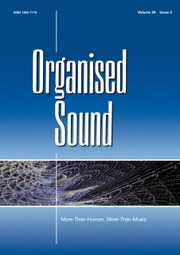No CrossRef data available.
Article contents
Ears to the Ground: Socially engaged sound art as learning in process
Published online by Cambridge University Press: 07 February 2022
Abstract
Braiding sound–listening–learning (encouraged by composer Pauline Oliveros) with critical consciousness (inspired by educator Paulo Freire), the authors led a location-specific, socially engaged sound art project in Rhode Island (USA). The authors describe a style of socially engaged sound art that approaches the object of art as a dialogic process of learning.
- Type
- Article
- Information
- Organised Sound , Volume 28 , Issue 1: Socially Engaged Sound Practices, Part 2 , April 2023 , pp. 3 - 12
- Copyright
- © The Author(s), 2022. Published by Cambridge University Press
References
References
Bishop, C. 2006. The Social Turn: Collaboration and Its Discontents. Artforum International. www.artforum.com/print/200602/the-social-turn-collaboration-and-its-discontents-10274 (accessed 1 April 2019).Google Scholar
Brockell, G. 2020. The Ugly Reason ‘The Star-Spangled Banner’ Didn’t Become Our National Anthem for a Century. The Washington Post, 18 October, www.washingtonpost.com/history/2020/10/18/star-spangled-banner-racist-national-anthem/ (26 November 2021).Google Scholar
Cardiff, J. n.d. The Walk Book. Vienna: Art Contemporary, in collaboration with Public Art Fund, New York. https://issuu.com/tba21/docs/the_walk_book_complete (accessed 1 December 2021).Google Scholar
Corbin, A. 1998. Village Bells: Sound and Meaning in the Nineteenth-Century French Countryside. New York: Columbia University Press.Google Scholar
Cusick, S. 2008. ‘You are in a place that is out of the world …’: Music in the Detention Camps of the ‘Global War on Terror’. Journal of the Society for American Music 2(1), 1–26.CrossRefGoogle Scholar
DeLuca, E. 2016. Wolf Listeners: An Introduction to the Acoustemological Politics and Poetics of Isle Royale National Park. Leonardo Music Journal 26, 87–90.CrossRefGoogle Scholar
DeNora, T. 2000. Music in Everyday Life. Cambridge: Cambridge University Press.CrossRefGoogle Scholar
Dunaway, J. 2020. The Forgotten 1979 MoMA Sound Art Exhibition. Resonance 1(1), 25–46.CrossRefGoogle Scholar
Feld, S. 1982. Sound and Sentiment: Birds, Weeping, Poetics, and Song in Kaluli Expression. Philadelphia: University of Pennsylvania Press.Google Scholar
Finkelpearl, T. 2012. What We Made: Conversations on Art and Social Cooperation. Durham, NC: Duke University Press.Google Scholar
Gautier, A. M. O. 2015. Silence. In Novak, D. and Sakakeeny, M. (eds.) Keywords in Sound. Durham, NC: Duke University Press, 183–92.Google Scholar
Haraway, D. 1991. A Cyborg Manifesto: Science, Technology, and Socialist-Feminism in the Late Twentieth Century. In Simians, Cyborgs, and Women: The Reinvention of Nature. New York: Routledge, 1991, 149–81.Google Scholar
Henriques, J. 2011. Sonic Bodies: Reggae Sound Systems, Performance Techniques, and Ways of Knowing. London: Bloomsbury Press.CrossRefGoogle Scholar
Kester, G. 2004. Conversation Pieces Community and Communication in Modern Art. Berkeley, CA: University of California Press.Google Scholar
Kim-Cohen, S. 2009. In the Blink of an Ear: Toward a Non-Cochlear Sonic Art. London: Bloomsbury Press.Google Scholar
Kisliuk, M. and Gross, K. 2004. What’s the ‘It’ That We Learn to Perform?: Teaching BaAka Music and Dance. In Solís, T. (ed.) Performing Ethnomusicology: Teaching and Representation in World Music Ensembles. Oakland, CA: University of California Press, 249–60.CrossRefGoogle Scholar
Krebs, S. 2012. Sobbing, Whining, Rumbling: Listening to Automobiles as Social Practice. In Bijsterveld, P. (ed.) The Oxford Handbook of Sound Studies. New York: Oxford University Press, 79–101.Google Scholar
Kwon, M. 1997. One Place after Another: Notes on Site Specificity. October, 80, 85–110. https://doi.org/10.2307/778809.CrossRefGoogle Scholar
Lee, T. S. 1999. Technology and the Production of Islamic Space: The Call to Prayer in Singapore. Ethnomusicology 43(1), 86–100.CrossRefGoogle Scholar
Mockus, M. 2008. Sounding Out: Pauline Oliveros and Lesbian Musicality. Abingdon: Routledge
Google Scholar
Novak, D. and Sakakeeny, M. (eds.) 2015. Keywords in Sound. Durham, NC: Duke University Press.Google Scholar
O’Brien, K. 2016. Listening as Activism: The ‘Sonic Meditations’ of Pauline Oliveros. The New Yorker, 9 December. www.newyorker.com/culture/culture-desk/listening-as-activism-the-sonic-meditations-of-pauline-oliveros (accessed 25 November 2021).Google Scholar
Oliveros, P. 2004. Harmonic Anatomy: Women in Improvisation. In Fischlin, D. and Heble, A. (eds.), The Other Side of Nowhere: Jazz, Improvisation, and Communities in Dialogue. Middletown: Wesleyan University Press, 50–70.Google Scholar
Ouzounian, G. 2013. Sound Installation Art: From Spatial Poetics to Politics, Aesthetics to Ethics. In Born, G. (ed.), Music, Sound, and Space. Cambridge: Cambridge University Press, 73–89.CrossRefGoogle Scholar
Stokes, K. 2020. God’s Little Acre: America’s Colonial African Cemetery. Colonial Cemetery. www.colonialcemetery.com/ (accessed 1 April 2019).Google Scholar
Robinson, D. 2020. Hungry Listening: Resonant Theory for Indigenous Sound Studies. Minneapolis: University of Minnesota Press.CrossRefGoogle Scholar
Rodgers, T. 2010. Pink Noises: Women on Electronic Music and Sound. Durham, NC: Duke University Press.Google Scholar
Rice, T. 2015. Listening. In D. Novak and M. Sakakeeny (eds.) Keywords in Sound. Durham, NC: Duke University Press, 99–111.CrossRefGoogle Scholar
Stoever, J. L. 2016. The Sonic Color Line: Race and the Cultural Politics of Listening. New York: New York University Press.CrossRefGoogle Scholar
Voegelin, S. 2018. The Political Possibility of Sound: Fragments of Listening. London: Bloomsbury Academic.Google Scholar
Westerkamp, H. 2007. Soundwalking. In Carlyle, A. (ed.), Autumn Leaves, Sound and the Environment in Artistic Practice. Paris: Double Entendre, 49–54.Google Scholar
Videography
Belmore, R. and Beaucage, M. 1992. Speaking to Their Mother. Vimeo. https://vimeo.com/99999913 (accessed 1 April 2019).Google Scholar



